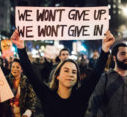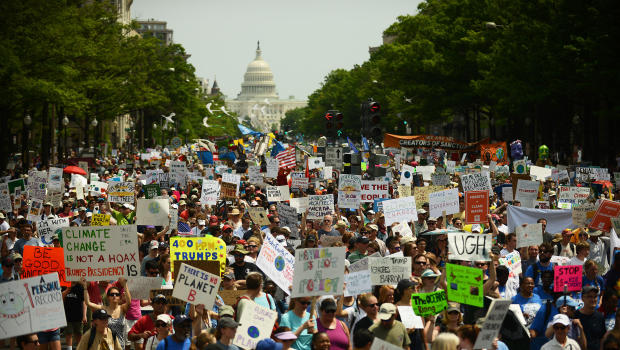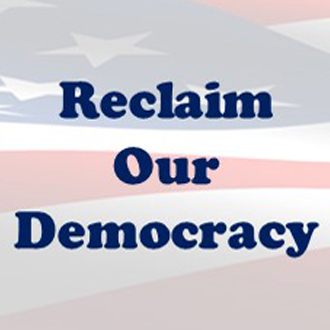“When a movement is strong enough it doesn’t matter who is in the White House; what really matters is what people do, and what people say, and what people demand.” [Howard Zinn]
“Public sentiment is everything. With public sentiment nothing can fail; without it, nothing can succeed.” [Abraham Lincoln]
“Whatever happens in Washington, in the months and years to come, Americans of all stripes who value their self-government must mobilize at every level — not simply once every four years but today and tomorrow and the next day — to win elections and help protect the basic functions of democracy. If people who believe in conspiracy theories can win, so can those who live in the reality-based world.” [New York Times Editorial Board]
Recruit and Organize
Start by identifying a group of people who are interested in working with you to help save our democracy. Bring them together in a meeting to discuss what you would like to accomplish and how you will go about it. Create a name for the group and develop a mission statement and some objectives that describe what you want to accomplish.
Strategize and Plan
Think about various ways you can achieve your objectives, and what activities (see some suggestions below) you can do that will move you in the right direction. Consider other groups you might want to work with. Discuss who you will invite to participate in your activities. Agree on what you will do and when you will do it. Divide up the tasks to be accomplished with the members of your group.
Take Actions
For each activity determine the people you want to invite and how you will publicize it, conduct the activity, and afterward evaluate how effective it was and what you want to improve for the next activity. Repeat this for all of the activities you have planned.
Evaluate and Expand
When you have completed the planned activities, it’s time to figure out how you can expand the impact you are having. How can you get more people involved, work with additional groups, reach a bigger audience? It may make sense for your members to join other similar groups, or at least develop a sharing relationship with them. You may want to consider being a small part of a much larger organization.
Once you have figured out next steps, begin the cycle again of recruiting, organizing, strategizing, planning and taking actions. Continue to loop around the cycle, expanding your impact until you have reached your objectives.
Movement Building Resources
The book Daring Democracy is an excellent source for building the movement. It encourages us to draw on the energy of hope, and to make the Democracy movement actively inclusive, embracing differences of race and culture with a common commitment to justice and democracy.
If we are to build a movement powerful enough to take on authoritarianism and big money, all of the democracy reform efforts need to work together, and join with other related movements: environmental justice, human rights, women’s empowerment, workers’ rights, immigration justice, and many others. Without democracy there’s almost no chance of tackling distinct environmental, racial justice, poverty or labor issues. If your own passion lies in one of these areas, imagine your own specific issue as a branch of a single majestic tree. Your bough is beautiful and needed, but its flourishing depends on a healthy trunk and root system (a functioning democratic government of the people, by the people, for the people).
According to the Resistance Guide, (another excellent resource), social movements can do more than shift opinion – they can make once-radical opinions into a new conventional wisdom.
In order to build a movement that is steadily growing you need three types of actions:
- Public protests that bring in new supporters and change people’s minds about what is politically possible
- Acts of resistance focused on people in power (politicians, corporations, billionaires)
- Electoral politics that oust the current representatives who oppose what we want and replace them ones who support what we want
Public Protests

In a democracy, public protest is the most effective way to be heard in the absence of either money or fame. Protest polarizes and successful polarization moves people from being neutral to being willing to take a stand. Even those who disapprove of protesters can come around to support their cause. Sacrifice and disruption are very important in capturing public attention. Sacrifice touches others by demonstrating seriousness of commitment. Disruption captures public attention, and often outweighs its alienating effect. However, violence and property destruction discourage participation and lessen a movement’s effectiveness. Avoid these tactics.

Sustained participation is important. It may take several protest events to make someone aware and several more to get them to pick a side. Keep showing up! Make your message clear: signs with easily understood concise statements; speak in sound bites that define problems and solutions and identify heroes and villains. Appeal to common sense values. One unified message over and over is stronger than varying the message event to event. Build support but don’t worry about winning everyone over. “Keep the pressure on with different tactics and actions, and utilize all events of the period for your purpose” [Saul Alinsky]. Organize game changing events such as the 2017 Women’s march (>4 million participants) and more frequent targeted events that can be duplicated week to week, preferably in different locations. Document the actions on social media and encourage your friends and followers to join with you.
Acts of Resistance Focused on People in Power

Target the powers that be, the decision-makers. Call, write or show up to communicate with legislators. Take actions to influence corporations as employees, customers or shareholders. Think about your sphere of influence where you can make your views known.
- Organize product boycotts or picketing
- Public disobedience – occupy a public or private space, sit-ins, sing-ins
- Block entry to legislative chambers
Electoral Politics

Many different political and democracy groups are very active around elections, particularly the Presidential and Midterm elections. Identify the groups you want to work with, either collectively or individually and support their efforts in whatever way you can. You can also do the following to influence your legislators.
- Become a citizen lobbyist both by phone and personal visits
- Join a group that meets with legislators on a regular basis
Some Other Ideas for Taking Action:
- Create a multicultural Democracy Fair event that brings people together to have fun, eat good foods, and learn about current issues facing democracy, the environment, immigration, racial justice, women’s health… The event could occur at a church or on a large mowed field with a parking lot. Exhibits would include food from around the world, relevant games, social justice booths, arts and crafts for sale from diverse organizations, and an area for debates, discussions, presentations, and meeting local government representatives. There could be opportunities for kids and their parents to learn about and experience democracy in action.
- Establish a writing group – letters to the editor, op-ed pieces, social media
- Share a link to this site ReclaimOurDemocracy.org with your friends and family.
- Start your own group Facebook page
- Assemble a small group of friends and neighbors to view one of the videos and then discuss it.
- Hand out cards at public events
- Celebrate democracy – share and teach songs related to freedom & democracy
- Organize a multi-group protest march with signs
- Organize highly visible citizen deliberations to choose long term strategies and priorities for immediate action
- Produce 3-5 minute YouTube videos on how people are affected by big money in politics, voter suppression, or authoritarianism
- Create and distribute bumper stickers
- Reach out to social justice groups in local churches, colleges and universities
- Become a hub for multiplying power and building community
- Organize a bike ride
- March in a parade
- Create new public spaces for community talk “People’s Corners”
- Change your Facebook page to show solidarity
- Create a group logo
- Appear on local access TV
Groups to Align With:
Declaration for American Democracy, League of Women Voters, Faithful Democracy, Poor People’s Campaign, Democracy Initiative, Democracy Matters, Common Cause, Public Citizen, Indivisible, Represent.US, Move On, Our Revolution, American Promise, Women’s March, Color of Change, Black Lives Matter, 350.org, Cosecha, Sunrise Movement

